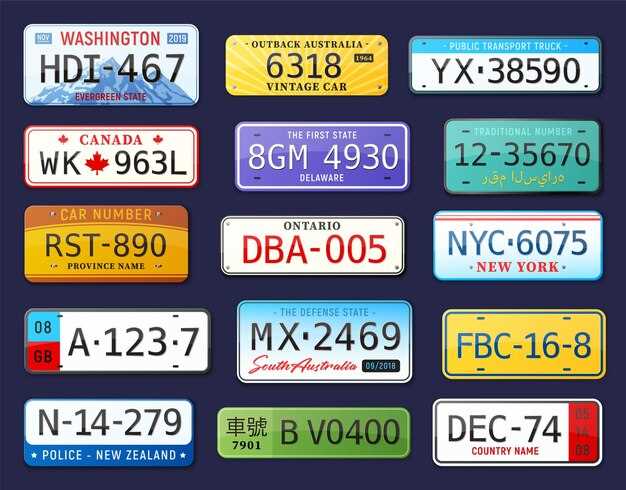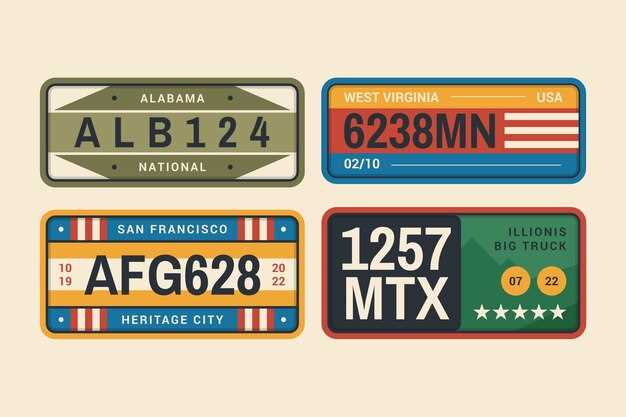
The history of vehicle tags and plates is deeply intertwined with the evolution of transportation and the need for regulation. As automobiles began to proliferate in the late 19th and early 20th centuries, the necessity for a systematic method of registration became evident. Initial efforts in vehicle identification were often informal, with owners painting identifying numbers on their cars. However, as the number of vehicles on the roads increased, the call for a standardized approach to registration led to the establishment of the first official vehicle plates.
In 1901, the first vehicle registration law was enacted in the United Kingdom, marking a significant turning point in transportation legislation. This law mandated that all vehicles display a unique identifying number, thereby providing law enforcement officials and the public with an efficient means of tracking ownership and accountability. Over the years, this model spread internationally, and by the 1910s, most countries had implemented mandatory vehicle tags and plates as a crucial aspect of road safety and regulatory compliance.
The significance of vehicle tags and plates extends beyond mere identification. They serve as a vital interface between the government and the vehicle owner, facilitating the registration process, tax collection, and enforcement of traffic regulations. Each plate is not just a unique identifier; it is a symbol of legal compliance and responsibility, reflecting the owner’s adherence to local laws and regulations. In today’s modern society, the importance of these vehicle plates continues to grow, with innovations such as digital plates and advanced tracking technologies shaping the future of vehicle registration.
Evolution of Vehicle Registration Practices Through the Decades
The evolution of vehicle registration practices has undergone significant transformations from the early 20th century to the present day. Initially, the concept of vehicle registration emerged in the 1900s as a response to the rising number of automobiles on the road. Vintage plates from this era were often handmade and featured unique identifiers assigned to each vehicle, marking the beginning of formal registration systems.
In the 1910s and 1920s, many states in the United States began to implement mandatory registration laws, requiring vehicle owners to obtain official plates. This period saw the introduction of standardized numbering systems, which enhanced the ability to identify vehicles. The designs of these plates varied widely, often reflecting local culture, with the inclusion of state mottos and symbols.
As the decades progressed, particularly during the post-World War II boom in the 1950s, the demand for vehicle registration grew tremendously. This led to more streamlined processes and the introduction of color-coded license plates that indicated registration expiration dates. Such practices not only provided functional benefits but also added a touch of aesthetic appeal, as states began to experiment with various colors and designs to symbolize their identity.
The 1980s and 1990s marked a technological leap, with many jurisdictions adopting computerized databases to manage registrations more efficiently. This digital shift facilitated easier tracking of vehicle ownership and provided law enforcement agencies with quick access to registration data. The innovation of reflective materials in plate production ensured better visibility at night, enhancing safety on the roads.
In the 21st century, vehicle registration practices continue to evolve with an increasing emphasis on environmental sustainability and technological advancements. Many states now offer personalized plates, which allow vehicle owners to display custom messages or images. Furthermore, electronic registration processes have gained popularity, allowing for more convenient and paperless transactions, further simplifying the registration experience.
Overall, the evolution of vehicle registration practices reflects broader changes in society, technology, and governance. From vintage plates to modern digital systems, each era has contributed to a more organized and efficient approach to vehicle identification and management, underscoring the significance of registration in maintaining road safety and order.
Understanding the Legal Importance of Vehicle Tags in Modern Transport

Vehicle tags, commonly referred to as license plates, serve as a crucial identification system in modern transportation. These plates not only display registration information but also reflect adherence to local laws and regulations. Each plate is unique, ensuring that vehicles can be distinguished from one another, which is vital for law enforcement and public safety.
The use of vehicle tags facilitates the tracking of ownership and can greatly assist in the recovery of stolen vehicles. Law enforcement agencies rely on plate recognition technology to monitor compliance with traffic laws and to identify vehicles involved in criminal activities. This capability reinforces the significance of having properly registered and displayed vintage and contemporary plates alike.
Moreover, vehicle tags are essential for the collection of road use taxes and fees. Many jurisdictions mandate that vehicle owners renew their tags annually, which contributes to public infrastructure funding. This system underscores the legal obligation placed on vehicle owners to maintain compliance with registration laws, promoting accountability and responsible vehicle ownership.
In addition to identification and compliance, vehicle tags can signify the type of vehicle, its age, and even its category, as seen with vintage plates. These often come with specific regulations that honor historical vehicles while encouraging preservation efforts. The legal framework surrounding these tags ensures that vintage vehicles are recognized and protected, thereby fostering a sense of heritage within the community.
In summary, the legal importance of vehicle tags extends beyond mere identification. They play a pivotal role in regulation, safety, and the preservation of automotive history, highlighting the intricate relationship between law, transportation, and society.
Exploring the Value and Appeal of Vintage License Plates

Vintage license plates have emerged as a unique niche within automotive memorabilia, captivating collectors and enthusiasts alike. Their historical significance and aesthetic charm make these plates highly sought after. Registration year, state of origin, and unique design elements contribute to their allure, often reflecting the cultural and technological milestones of their time.
The appeal of these plates extends beyond mere decoration; they serve as tangible connections to automotive history. Each plate tells a story, representing not just a vehicle, but an era. Collectors often seek specific years or designs that resonate with their personal experiences or represent significant moments in automotive innovation. For instance, plates from the early to mid-20th century often showcase distinctive artwork and typography, showcasing the design philosophies of their respective periods.
Furthermore, vintage plates have become a popular investment option. As more individuals recognize their historical and artistic value, prices for rare designs have increased. Certain plates, especially those associated with classic cars or known events, can fetch impressive sums at auctions. This growing market has generated a community of collectors who engage in trade and discussions about the best ways to preserve their prized registration items.
In addition to their monetary value, vintage license plates evoke nostalgia. They remind many of a time when cars were not just vehicles but symbols of freedom and adventure. Utilizing these plates in modern design, such as in artwork or home decor, helps to keep the spirit of this era alive while celebrating the evolution of automotive culture.
Ultimately, the value and appeal of vintage license plates lie in their rich history, artistic designs, and the emotional connections they foster. As automobiles continue to evolve, these plates serve as a bridge to the past, allowing current generations to appreciate the journey of automotive development while sparking interest in the future.












